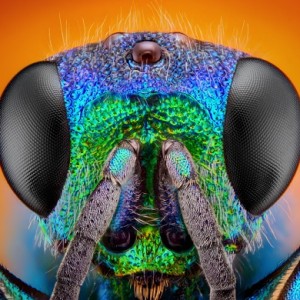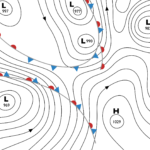
What is Entomology?
Entomology is now a well-established degree and with the scope of the environmental sciences continuing to expand, the evidence that we can acquire from it is expected to continue to have the broadest possible appeal. Though classed as a subsection of zoology, it is a deep enough subject to require specific undergraduate and postgraduate qualifications.
Entomology usually comes under the control of biology or agriculture departments, and most universities in the world offer courses in entomology. At least one college in each US state offers it as an undergraduate program. Students wishing to take advanced degrees and PhD programmes have a lot of choice; most research roles will require at least a Master's level degree - if not a Doctorate. Most entomologists go on to work in agriculture and conservation, in ecology and land management (national parks for example).
Put simply, entomology is a branch of zoology (the study of animals) that studies insects and how they interact with their environment, other species and humans (1). The word originates - as most scientific classifications do - with a Greek word: entom, meaning “notched”. An animal is an insect when it has segmented body parts. Insects are quite remarkable creatures and we have identified in the region of 1 million species with estimates of the number of unidentified species ranging from 5 million to 8 million (2). Insects exist all over the world and survive in some of the harshest environments on earth; it is believed that they - in terms of numbers - outnumber all other animal species combined (3).
Learn more about zoologist careers, parasitologist careers, and parasitology.
What is an Insect?
It may seem like a simple question, but there is some confusion over what is and what is not an insect.
There are certain criteria by which we define which creatures are insects. For starters, they must have an exoskeleton - this is common to all arthropods. In order for the arthropod to be an insect, the specimen must have six legs - this is generally what separates them from other arthropods. They also have three distinct body parts broken down into the head, abdomen and thorax. They may or may not have wings, or antennae, or both (4) and they may live on land, in the air or in bodies of water (though there are not many marine species as these environments are dominated by other types of arthropods).
Most insects have compound eyes that are large relative to their bodies, though some are eyeless (5) and many have ocelli (sensors that fulfill some functions of eyes in other species) (6, p14-15). Combined, the compound eyes, antennae and ocelli perform most sensory functions of the insect. Sensory hairs on the bodies of many insects tell them the direction the wind is blowing, so if they smell food, they know what direction to fly or crawl to find it.
"Not all insects have ocelli - in fact, this is a distinguishing character at the taxonomic level of orders. Some type of beetles for example such as the subfamily Omaliinae of the Staphylinidae do have ocelli while most beetle types do not. Beetles about 40% of all named insect species." Robert E. Nelson, Professor of Geology, Colby College
Learn more about how to become an entomologist.
A History of Entomology
Humans have always been interested in insects for one reason or another; ancient cultures have examined, farmed and even venerated them.
Ancient Egyptians worshipped a large species of dung beetle, or Scarab, that would gather balls of dung and bury them. The female would lay eggs on the dung, and then weeks or months later, new beetles would emerge from the ground - seemingly reborn from nothing and thus representing the renewal of life. Even before this, some of the earliest cave art depicts bees - one famous example at Cuevas de la Araña en Bicorp in eastern Spain shows a human figure surrounded by bees (7), while he or she (the figure is androgynous) gathers honey from a hive. Many Roman writers discussed insects and Aristotle and Pliny the Elder both had a strong fascination in which they published their observations of insects in books on natural history.
The true scientific study of insects did not develop until the Renaissance and through to the Enlightenment era - with the greatest expansion of the subject seeming to be the 1800s. Three strands of study grew up in a very short space of time: first there were the researchers who wanted to depict nature's beauty through producing highly detailed image. This wasn't just useful for art's sake, these highly detailed sketches were useful to researchers wanting to understand the insects' physiology.
The second group concerned itself (as many natural sciences did) with classification, dividing for the sake of convenience and ease of study - still a common practice today and we still use the division method in classification of new species, even where and when we realise that not all species of anything fit neatly into boxes. The third group focused largely on examining the biological processes of insects - life cycle, reproduction, habitats and other elements.
This developed through the course of the 18th century and by the 19th century most major universities were studying the world's insects and major scientific institutes began a systematic program of research and investigation. In North America and in Europe, the Victorian era saw the greatest expansion of interest of insects (8) firstly through the amateur research of the well to do gentleman researcher, and later into more academic study leading to the formalised science that we have today.
There is no greater work with such a wide scope for this third group, than the four volumes published in the early 19th century by William Kirby and William Spence (9) and it is still considered a seminal work today. For the most part, this 19th century research into insects was driven by medical science and a need to understand and combat diseases carried by insects such as malaria and yellow fever (10), their causes and how they spread. It was important to the colonialism and the growing market economy of nations spreading their influence and building markets in developing countries. That's not to say that study for study's sake was not an issue as it was with so many other 18th and 19th century naturalists, because it was. As humans we are driven to examining and understanding the world around us.
The 20th and 21st centuries led to the more discoveries of insect species, and how they live and reproduce, than ever before. Now we can visit very remote areas far more easily than we could before - new species turn up every day. We have also discovered that the study of insects has uses outside of entomology.
What Can Entomology Tell Us?
The subject does not exist in a bubble where it is useful only to itself; it is part of a wider environmental study of our natural ecology and human geography - insects are affected by the climate and results of studies can tell us much about what is going on in the world around us. We discover new uses for studies in entomology all the time and there are already several established disciplines where insects and insect remains are a powerful type of evidence.
As Environmental Indicators
Insects are a vital part of forest biodiversity and as they are particularly sensitive to changes in the climate and the patterns and seasons of regional flora cover, entomology provides evidence for general forest health (11) as well changes in the cover. The arrival of a new pest or the sudden decline of a well-established native species can indicate many things, such as the effects of deforestation, or a change in the types of arboreal cover, CO2 concentration, persistent ecological issues such as drought or flooding. They can tell us much about the types of trees, shrubs and flowers that grow there (especially pollinating insects such as butterflies) (12, p28-30) and any changes.
The Arctic Circle has a very delicate ecosystem and this is one area where researchers in many fields rely heavily on entomology, particularly of the relationship between insect groups, between insects and the environment, between insects and other animal species; evidence from population numbers and density is often used to examine specific environmental indicators (13).
For Archaeology / Anthropology
Similarly, and as archaeology moves more into the realm of environmental science, insect population and remains are becoming more important in the interpretation of archaeological sites and landscapes. Humans have had an enormous impact on the environment of the past, and we are just beginning to understand how geoengineering, how hunter-gatherer societies and even the Neolithic Agricultural Revolution impacted local ecologies. We are only now beginning to understand how insect remains are useful, and indeed which insect species are most useful in which areas. In a study of western Greenland for example, researchers examined extant insect remains for indicators of personal hygiene (14).
This isn't all they can tell us though. When a virgin landscape is altered to make way for farmland, there is likely to be a change to the ecosystem that will include a change of both the pollen distribution pattern and insect remains - especially where a crop favourable to native insect species replaces a crop that was unfavourable, or vice versa. In these cases, there will be a clear and distinct pattern change in the archaeological record.
Forensic Entomology
It may surprise people to learn that insect species can sometimes play a part in criminal investigation and even be included as part of the evidence. We can learn much about a body's season of death and for how long it may have been exposed to the elements before discovery or being buried (15). This is one of the most critical areas in which entomology contributes to our understanding of human remains - in archaeology and in criminal proceedings.
Insects are attracted to decomposing bodies and may begin feeding off it or laying eggs in it. By understanding the lifecycle process of any insect remains found, investigators can identify how long a body has been dead, where it has been storied and a variety of other facts. Most interestingly, it seems that studying insects as a method of working out the perpetrator of a murder goes back to China in the 13th century (16) when suspects were told to lay their sickles on the ground to see which attracted the most flies to the small amounts of blood that remained on the blade. Using insects as evidence in a modern criminal trial began in 1935 when a body in the UK showed a number of blowflies. The subsequent evidence attained from the blowflies informed investigators how long the woman had been dead and led to a conviction of the guilty party (17).
Medical Entomology
This is the area concerned with medical research and how insects are a matter of public health. This area also includes plant disease and damage caused by insects to crops too. That means researchers in Medical Entomology are concerned with urban and rural pests as well as the diseases that some insects carry. The scope of medical entomology will also cover research into the effectiveness of, and development of new, pesticides.
Medical entomology arguably began in the early 20th century when it was discovered that mosquitoes were responsible for the transmission of Yellow Fever. Medical entomology plays a large part of the US military research as the major bodies examined and combated the effects of major diseases in all wars the country has participated in (18) - most recently in Iraq and Afghanistan. Though entomology is the study of insects, medical entomology has a broader scope in that it incorporates other arthropods that may affect human health - this means arachnids such as spiders, mites, ticks and also come under the scope of a medical entomology researcher.
Fruit Fly Research
The humble fruit fly deserves a special mention because these small insects have given us so much information. We have learnt much about evolutionary biology because many generations breed in a very short space of time (20). We have information on genetic mutation, genetic drift and other elements of evolution vital to research in other areas, particularly human genetics. Selective cross-breeding for favourable traits may be carried out on a large scale in a very short space of time. Though they have been studied for at least a century, only recently have researchers made great leaps in discoveries.
Recent research has also shown that there may be discoveries waiting to be made for diabetes research. A paper published in 2014 shows that the research team discovered a way of measuring mutations in relation to insulin levels (21). It is hoped and expected that future diabetes treatments will results from the study.
Learn more about how to become an entomologist.
Sources
- http://entomology.wsu.edu/prospective-students/the-what-why-of-entomology/
- http://www.open.edu/openlearn/nature-environment/natural-history/what-entomology
- http://entomology.osu.edu/node/226
- http://eol.org/info/446
- http://jeb.biologists.org/content/24/3-4/211.full.pdf
- http://www.lib.ncsu.edu/archivedexhibits/tippmann/victorian.html
- http://www.cdc.gov/malaria/about/history/ross.html
- http://www.ncbi.nlm.nih.gov/pubmed/18839929
- http://www.bio-nica.info/biblioteca/BrownJr1997Disturbance.pdf
- http://pubs.aina.ucalgary.ca/arctic/Arctic45-2-159.pdf
- http://www.academia.edu/1341205/Special_Features_Articles_sp%C3%A9ciaux_-_How_entomology_can_help_us_interpret_archaeological_sites_Archaeoentomology_in_Greenland
- http://eprints.hud.ac.uk/11658/
- http://www.ncbi.nlm.nih.gov/pmc/articles/PMC3296382/
- http://www.afpmb.org/content/united-states-air-force-medical-entomology
- http://www.genescient.com/research/why-fruit-flies/
- https://med.stanford.edu/news/all-news/2014/08/researchers-use-fruit-flies-to-unlock-mysteries-of-human-diabete.html
- https://med.stanford.edu/news/all-news/2014/08/researchers-use-fruit-flies-to-unlock-mysteries-of-human-diabete.html
- Guide to Parasitology - November 19, 2018
- Deserts as Ecosystems and Why They Need Protecting - November 19, 2018
- Conservation: History and Future - September 14, 2018
Related Articles
Featured Article

What Is Sustainability and Why Is It Important?





